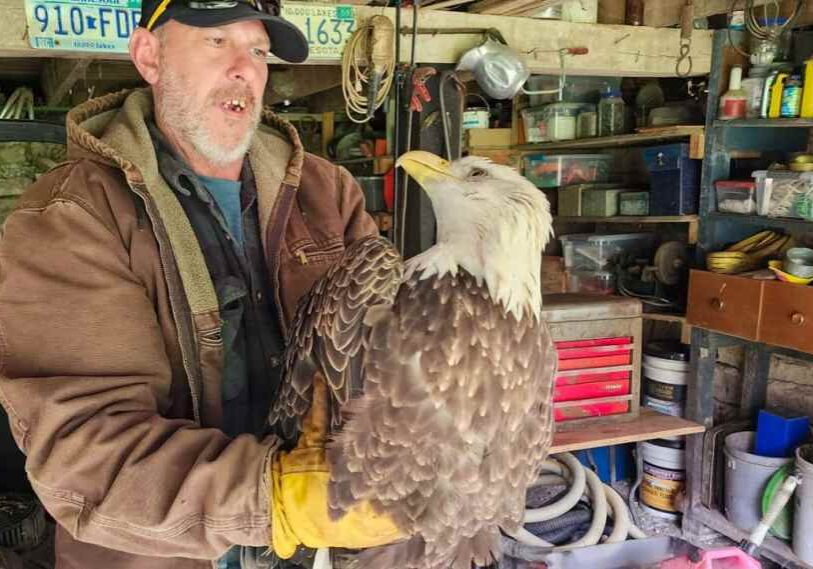For Love of the Big River

WINONA — Being told a few months ago that he was to receive a major award for work he’s done over the past 31 years sharing stories of the Mississippi River through Big River Magazine nearly brought tears to Reggie McLeod’s eyes.
They were not for the reason you’d think.
McLeod said he got the news about being inducted into the 2023 Hall of Fame at the National Mississippi River Museum & Aquarium in Dubuque, Iowa, from a friend in Iowa. “At first I almost teared up because I was at my mothers’ house cleaning it up to sell it,” he said.

Reggie McLeod with the three trophies in his downtown Winona office. From left, hot dish winner, Hall of Fame from the National Mississippi River Museum & Aquarium in Dubuque, Iowa and one from River Action.
“We had just moved her into a memory unit and so I was feeling emotionally vulnerable. . . It was hard to process, I felt disoriented in a nice way. I was very happy to hear about it.”
It also hit him in part because “I have never been that interested in entering contests or competitions,” he said.
McLeod, however, is very interested, even passionate, about the river that flows through the heart of the Driftless Area of southeast Minnesota, southwest Wisconsin, northeast Iowa and a bit of northwest Illinois. He wants readers to know about the river’s problems and beauty, its people and towns. That’s why he started Big River, that’s why he’s planning on a way to keep the words and editions flowing now that he’s contemplating taking it a bit easier.
When we talked recently about starting and continuing to publish Big River Magazine in Winona, McLeod explained more about his award, and magazine, and also found some self-deprecating humor, which is typical of him.
There are two categories of the awards. One is for the likes of Mark Twain, John Muir and Aldo Leopold, the giants of the Mississippi and the environment nationally, who have died. “These men and women made significant contributions related to America’s rivers,” according to the museum.
The second category is for the living. “I was pleased to find I was in the second category,” he said.
Various honors
It’s not his only honor. He has two other trophies in one of the rooms where Big River is published in the second story of a downtown Winona store a scant few blocks from the Mississippi. One is from River Action, a Davenport, Iowa, environmental group that honored McLeod in 2018 for going “against the current in relentlessly pursuing excellence on our river.”
His biggest trophy, which is a bit outlandish, is for winning the International Hotdish Championship in Winona several years ago. He was encouraged to enter the contest and thought about a recipe he’s been tweaking and improving for 20 years. He made it, walked through a blizzard to get it to the judges and won firsts for the most creative name and best hot dish for his Quasi Euro-American Squash Hot Dish with Lumps.
“I’m very happy with all of them,” he said. “I think it was easier to deal with the hot dish championship” because it’s so local.
He did have to travel to Dubuque for his November 2023 Hall of Fame honor and was relieved to find out there was no band so he didn’t have to dance.
The honoree is a man who grew up in Detroit and didn’t even see the Mississippi until he was a young man. Friends from Milwaukee took him to Wyalusing State Park near Prairie du Chien in southwest Wisconsin. McLeod walked to the edge of a bluff and looked over.
What’s that, he asked his friends.
It’s the Mississippi River, they said.
Nah, McLeod said, the Mississippi is in Louisiana.
He quickly learned the error of his ways and nearly as quickly fell in love with the river, its history, its people, its beauty and its beastly times of floods.

Issues of Big River Magazine.
“Subjectively, the Upper Mississippi River and Driftless Area are important because I am in love with this river and this place,” he said. “Shortly after moving here, I realized that I would spend the rest of my life here.”
“I suppose that Big River Magazine is an expression of that — something that our readers and our staff and I have in common,” he said.
He became a freelance journalist and editor, specializing in the river. That specialty indirectly led to the magazine, he said.
In the late 1980s, the river and Lake Pepin, a large natural lake of the river, were poorly-treated with wastewater from the Twin Cities that was causing fish kills and ugly water. Angry river and lake lovers met in Wabasha to begin working to force changes.
McLeod covered it but when he talked with big-city editors in St. Paul and Milwaukee, they at first didn’t want to give the meeting much coverage, if at all.
Big River Magazine
“That got me to thinking about coverage of the river,” McLeod said. “I loved going on the river and asking people questions and learning things about it. . . (I realized) the river doesn’t get covered very well.” His first issue came out in 1993.
“We are a river magazine,” he said. “Our goal is good regional journalism. We are not beating the drum for any specific cause. We want to write about a lot of different causes. The river is so many things for so many people.”
For towboat pilots, he added, the Mississippi is a highway; for anglers, hunters, powerboaters and paddlers, it’s a great place to recreate; for birders, it’s a heavenly place to see hundreds of species.

Molly McGuire, associate editor of Big River Magazine, works on her computer at the magazine office in downtown Winona.
He’s looked around and has never found another magazine devoted to a single river as Big River. The reason is that it’s a lousy business model, he said.
Businesses like to be in the center of a large territory while the Mississippi he covers stretches a very thin 400 miles from the Twin Cities to the Quad Cities. He knows the river depends on feeder rivers and the land along it so he’s decided to expand coverage to include more of the Driftless Area.
“A lot of our function is to share ideas and so people in one community can see what’s happening in another community,” McLeod said.
He’s noticed that many of his subscribers are from smaller towns such as Wabasha and Brownsville. “A lot of them are living there just because of the river,” McLeod said.
“People usually first inhabited places by water; it’s innate, it’s built into our DNA to want to live close to water,” he said. “There is something intrinsically beautiful and soothing, reassuring about rivers, living along rivers.” Wildlife and scenery are secondary.
Mississippi Watershed
It’s when he talks about the impact of the smaller rivers, and the land feeding the river, that McLeod gets serious. “The Mississippi concentrates the sins of everything that is happening in the watershed,” he said. When he began seeing the river, pollution from cities and towns was a huge issue. Thanks to billions of dollars, and lawsuits, many of those woes are gone.
“But the big issue now is agricultural pollution,” he said. “That is totally unregulated and it’s getting worse and worse. . .it’s kind of an indicator of what’s happening upstream.”
The Mississippi gets the nitrates and sediment from the Minnesota, Chippewa, Zumbro, Black, and Root rivers–so many smaller streams and rivers, he said. The entire watershed is the problem. All of that pollution, mostly nitrates, gets worse the farther downriver you go until it has turned the Gulf of Mexico, where the river enters it, into a zone without enough oxygen for many fish and other life forms.

Reggie McLeod works with Kelsey Firtzgerald, bookkeeper and subscriptions manager for Big River Magazine.
Let’s not let the woes and problems overshadow the good, he said. “If you’re interested in wildlife and biodiversity and things like that, the rivers connect things,” he said. He can walk home on a cold November evening and hear flocks of Tundra swans flying overhead. He sees bald eagles all the time because the river is the major continental bird migration corridor just like smaller ones, such as the Zumbro or Root, are corridors for wildlife such as bobcats and fishers to move into this region.
“I live here because of the river, because of the beauty,” he said. “The drive from here to La Crosse is one of the most beautiful drives I have ever been on anywhere.”
He intends to keep living along the river, and helping with Big River though he’s working on turning it into a non-profit that will allow the magazine to do more investigative journalism. “That’s our goal for the future,” he said. “I’m a better writer and editor than I am a businessman. . .I’m inspired to do this.”






